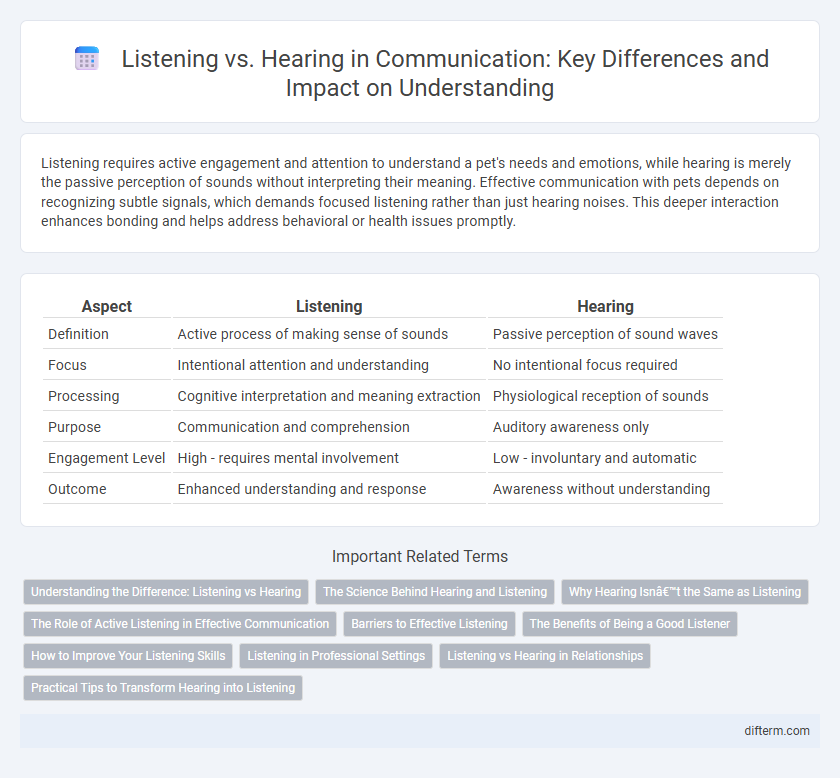Listening requires active engagement and attention to understand a pet's needs and emotions, while hearing is merely the passive perception of sounds without interpreting their meaning. Effective communication with pets depends on recognizing subtle signals, which demands focused listening rather than just hearing noises. This deeper interaction enhances bonding and helps address behavioral or health issues promptly.
Table of Comparison
| Aspect | Listening | Hearing |
|---|---|---|
| Definition | Active process of making sense of sounds | Passive perception of sound waves |
| Focus | Intentional attention and understanding | No intentional focus required |
| Processing | Cognitive interpretation and meaning extraction | Physiological reception of sounds |
| Purpose | Communication and comprehension | Auditory awareness only |
| Engagement Level | High - requires mental involvement | Low - involuntary and automatic |
| Outcome | Enhanced understanding and response | Awareness without understanding |
Understanding the Difference: Listening vs Hearing
Listening involves actively processing and interpreting sounds to grasp meaning, while hearing is the passive perception of sound without engagement. Effective communication relies on listening to accurately comprehend messages, rather than merely hearing sounds. Skills in active listening enhance mutual understanding and reduce miscommunication.
The Science Behind Hearing and Listening
Hearing is the passive process of detecting sound waves through the ear, involving the auditory system's reception of stimuli without conscious effort. Listening requires active cognitive engagement, where the brain processes, interprets, and assigns meaning to the sounds, involving areas like the auditory cortex and prefrontal cortex. Neuroscientific studies reveal that listening activates neural pathways responsible for attention, memory, and comprehension, highlighting its critical role in effective communication.
Why Hearing Isn’t the Same as Listening
Hearing is the passive process of perceiving sound without conscious effort, while listening requires active attention and cognitive engagement to interpret and understand the message. Effective communication depends on listening, as it involves processing information, responding appropriately, and retaining key details, unlike hearing which merely registers auditory stimuli. This distinction highlights why improving listening skills enhances interpersonal connections and reduces misunderstandings in both personal and professional contexts.
The Role of Active Listening in Effective Communication
Active listening plays a critical role in effective communication by ensuring that messages are truly understood rather than just heard. Unlike passive hearing, active listening involves attentively decoding verbal and nonverbal cues, providing feedback, and engaging empathetically with the speaker. This process enhances clarity, reduces misunderstandings, and fosters meaningful interpersonal connections.
Barriers to Effective Listening
Barriers to effective listening include internal distractions such as preconceived notions and emotional biases that distort message interpretation, along with external noise that disrupts auditory perception. Cognitive overload and lack of attention reduce the ability to process and retain information, causing listeners to hear but not truly understand the speaker's message. Effective communication requires overcoming these obstacles by cultivating active listening skills and minimizing environmental and psychological interference.
The Benefits of Being a Good Listener
Effective listening enhances understanding, fosters trust, and strengthens relationships by allowing individuals to fully grasp the speaker's message and emotions. Good listeners improve problem-solving skills and reduce misunderstandings, leading to more productive and meaningful communication. Developing active listening techniques boosts empathy, creating a supportive environment that encourages open dialogue and collaboration.
How to Improve Your Listening Skills
Improving your listening skills requires active engagement, such as maintaining eye contact, avoiding interruptions, and providing feedback through nods or verbal affirmations. Practicing mindfulness helps to block out external distractions and focus fully on the speaker's message. Developing empathy and asking clarifying questions ensures a deeper understanding and reduces miscommunication in conversations.
Listening in Professional Settings
Effective listening in professional settings enhances collaboration and reduces misunderstandings by actively engaging with the speaker's message. Unlike hearing, which is passive, listening requires concentration, interpretation, and feedback, fostering clearer communication and stronger workplace relationships. Mastering active listening skills improves decision-making and team productivity, crucial for leadership and project management success.
Listening vs Hearing in Relationships
Listening in relationships involves actively engaging with the speaker's words, emotions, and intentions, fostering deeper understanding and trust. Hearing is simply perceiving sound without processing meaning, which can lead to miscommunication and emotional distance. Effective listening strengthens connections by validating feelings and encouraging open dialogue, essential for healthy, lasting relationships.
Practical Tips to Transform Hearing into Listening
Effective communication requires shifting from passive hearing to active listening by fully concentrating on the speaker's message and providing feedback. Techniques such as maintaining eye contact, avoiding interruptions, and summarizing key points enhance comprehension and foster meaningful dialogue. Practicing mindfulness and minimizing external distractions further transforms hearing into purposeful listening, improving interpersonal connections.
listening vs hearing Infographic

 difterm.com
difterm.com